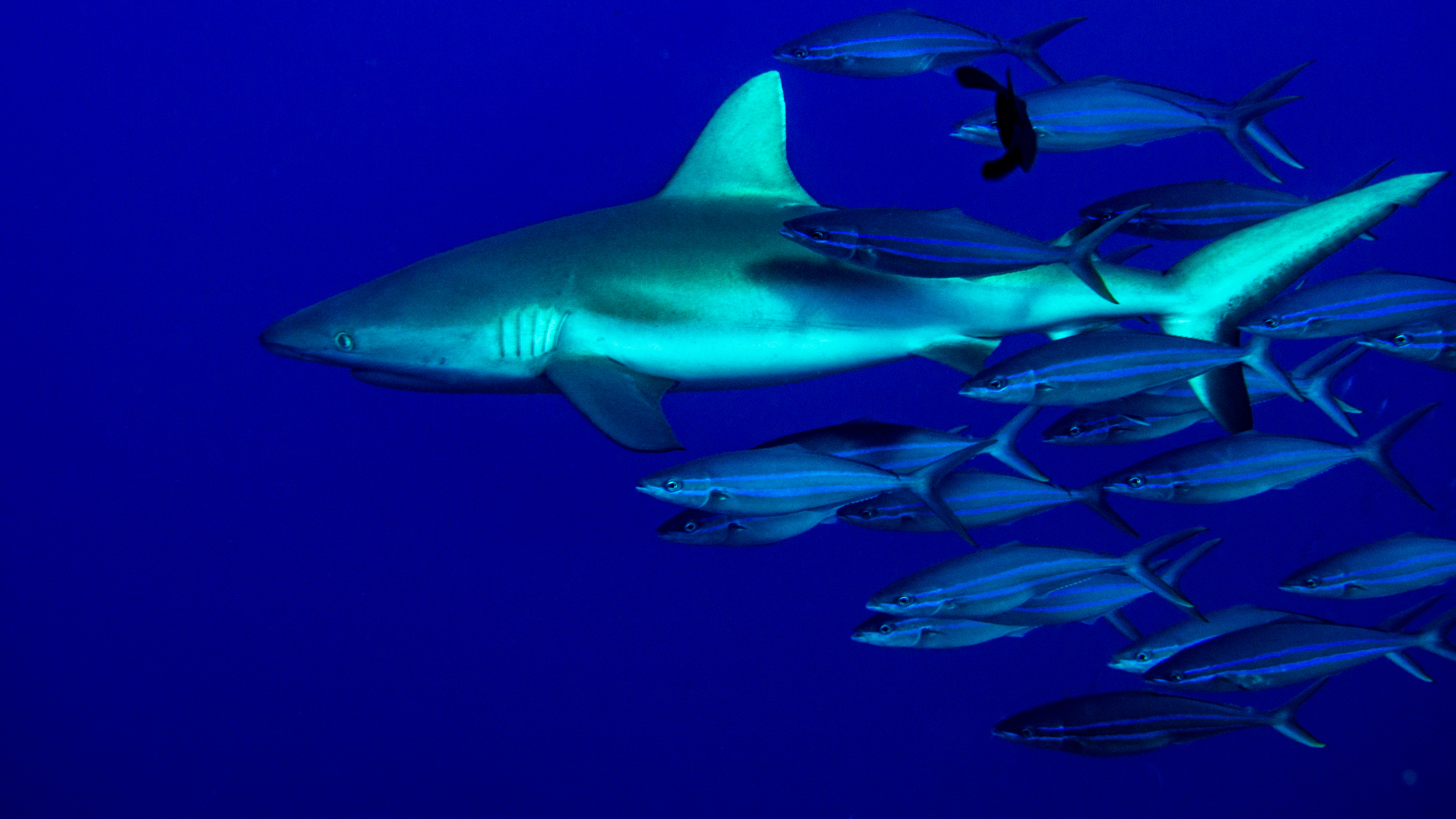Palau was on Bill’s bucket list as one of the many places we needed to dive. He wanted to do a live-aboard to ensure we could see all the best sites. He researched lots of boats, looking for one with a cabin that was acceptable to me. We have been on a few live-aboard dive trips and I do not like the tiny cabins with only a port hole for natural light and having a marine toilet in the shower is so gross. A week is a long time to be stuck in a place that I don’t like, so he knew that if he wanted me to agree to go, it had to be better than our previous live-aboard experiences. It was not easy to find, even though we were searching more than six months out, but Bill has an almost limitless ability to search on line for the best options (when it’s something that I want, no sacrifice is too great). We booked the Captain’s cabin on Solitude One, a 170-foot long ship that had undergone a complete makeover in 2013.
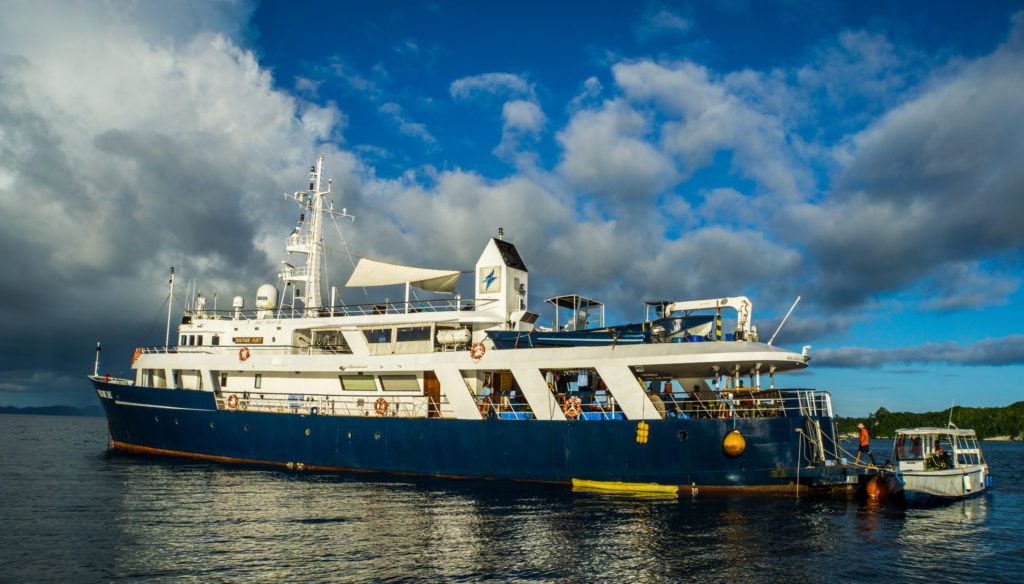
Solitude One
Palau was designated a World Heritage Site in 2012 and is comprised of 340 limestone and coral islands about 1000 miles south east of Manilla (essentially in the middle of nowhere which is what makes it a great diving destination). Palau was conquered by the Japanese during WW1 and was hotly contested during the pacific campaigns of WW2. The US finally captured the island chain in 1944 after the Battle of Peleliu, where more than 2,000 Americans and 10,000 Japanese were killed (the highest casualty rate of all amphibious operations during the Pacific War). In 1952 Palau created a marine conservation area, only accessible for research, and in 2009 they created the world’s first shark sanctuary, banning all shark fishing within its’ waters. This sanctuary protects about 230,000 square miles of ocean but with their limited resources they struggle to police it. Their efforts to stop poaching have gone so far as to burn foreign fishing boats when they are caught. Recognizing the value of renewable diving tourism, they are working to a create a no-take Marine Sanctuary that covers 80% of their Exclusive Economic Zone.
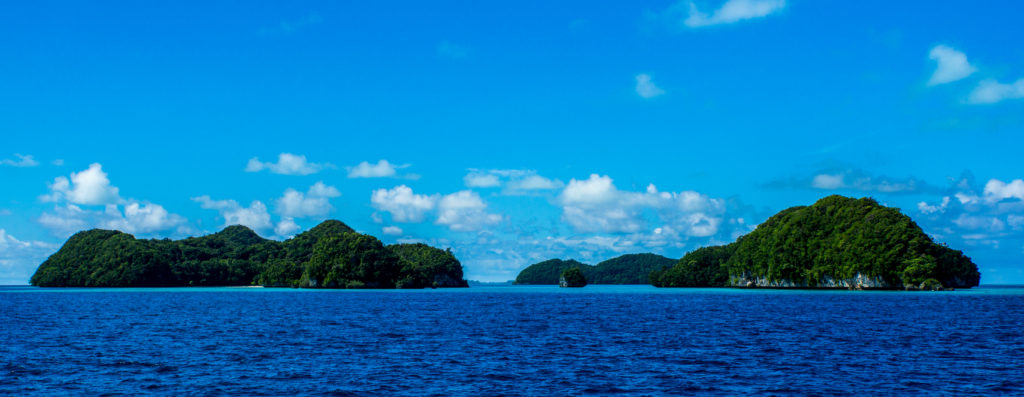
Rock Islands
Bill wanted to dive Palau so badly I don’t think he realized just how difficult getting there was going to be. Each individual step in the plan that we booked last fall seemed acceptable but the reality of the actual experience of the end to end trip was something else altogether. There are very few flight options to get to Palau and given we wanted a reputable airline, our options were even more limited. Our dive trip started on a Tuesday evening, and we had two flight options with United. We could either arrive four days early or take a chance and arrive six hours after boarding was supposed to start. Turns out that the boat would have waited for us, but not trusting the airlines, we opted for the extra four days in Palau where there is almost nothing to do (except of course diving which we already had covered).

Anemonefish
We flew from Kuala Lumpur to Manilla, where we had a 10-hour layover. Such a long layover is never fun, but to make matters worse, the Manilla airport sucks. We had to sit in the check-in area till two hours before our 10pm flight. No food or beer, and there were so many people waiting, we only ever got one seat (picture a small, dirty school auditorium with 75 cheap plastic chairs and 200-300 people plus luggage milling around). The highlight was the two hours of internet they offered (it wasn’t fast but it was free). The other side of security wasn’t a lot better but at least I could get a beer. We finally arrived and got checked in to our hotel about 3:30am, 20 hours after we left the apartment in Kuala Lumpur (but only 7 hours of flying time).
With no Airbnb options, and only one four-star hotel available at $500 a night (which I vetoed), we decided on the Palasia Palau hotel in Koror (this property wouldn’t normally be an option for Dessa but beggars can’t be choosers, we did book a Junior Suite to help compensate). The hotel was actually pretty nice especially given that they upgraded us to a large Executive suite with a separate bedroom and 1.5 baths. The pool was warm and the gym was well equipped. The staff was excellent, but the internet service was absolutely terrible (the service in the room available for a fee was completely unusable and the service in the lobby was only a little better).
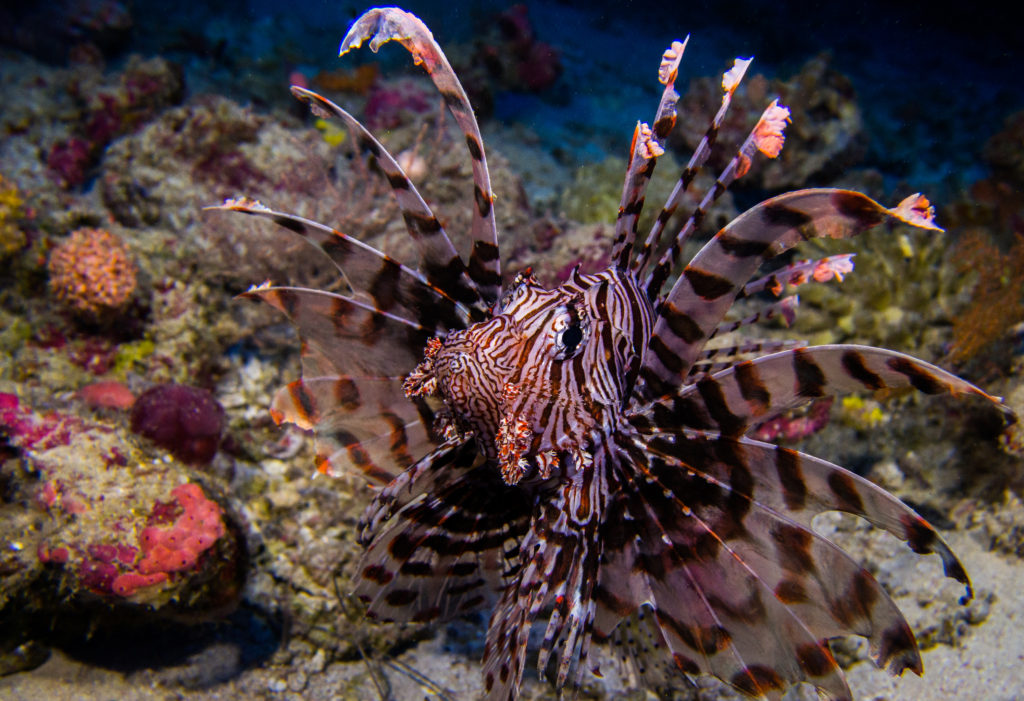
Lion Fish
Koror, the largest town in Palau is home to roughly 50% of the country’s 22,000 people. The downtown strip (if you can call it that) was about 3 blocks long, with lots of grocery/convenience stores and seedy restaurants. The first night we went in search of a burger joint that had good reviews on Google only to discover it was actually only a shack beside the local baseball field. While we waited for our food, I saw another rat scurry by. I am beginning to feel a little like the pied piper (setting aside the rat problem, the burger and fries were actually pretty good). We had some wonderful Indian food at what was probably the nicest restaurant in town and found excellent Thai food at a hole in the wall that Google also recommended (this ‘restaurant’ appeared to be the living room of an apartment with absolutely no décor and the old woman who cooked the food could only make 1 dish at a time, so dinner took a while).
At last it was time to board… Our cabin was about 4 times bigger than the standard cabin, with a king size bed, a day bed, a desk, lots of storage, a normal full-sized bathroom with a big walk in shower, and two large windows. Yea!!! The boat and décor however were far from new regardless of the 2013 makeover. More good news, there were only ten passengers on board, including us, with two more coming in the next day (a full boat would have meant 22 divers). It is always better to have fewer divers, so we were happy about that.

Jellyfish
The plan for this trip was like all live-aboards. The daily schedule is eat, dive, eat, dive, eat, dive, eat, dive, sleep, repeat. The service and crew were excellent, they took care of all our gear, washing it out and hanging it to dry after every dive. They also switched out our tanks so all we had to do was put on our wetsuits and step onto the small boat that took us out to the dive site (I was surprised that we needed a tender to get to each dive site, on previous live-aboards we’ve dove right off the rear deck). When we returned, they had hot or cold cloths waiting, hot drinks after the night dives, and hot showers on the deck to wash the sea water off. The food was all buffet style, plentiful, and very good. Desert after every meal, and snacks in case you didn’t get enough at meals. The only negative, is a hard and fast rule that your first alcoholic beverage means no more diving that day – not fair!
On our first day we had to stay close to the harbor as our late couple had been further delayed due to a flight cancelation. Our dive plan was adjusted for the local harbor sites which included two wrecks and Chandelier Cave. The cave was really beautiful; we have done caves before but have not been impressed by them. This one was pristine, with crystal clear water and four large chambers. Each one had an air pocket that we could come up into, there was no sea life, but lots of huge stalactites. The view from under the water was so clear, we could see everything above, and when we were up in the air pocket the light reflections were beautiful.
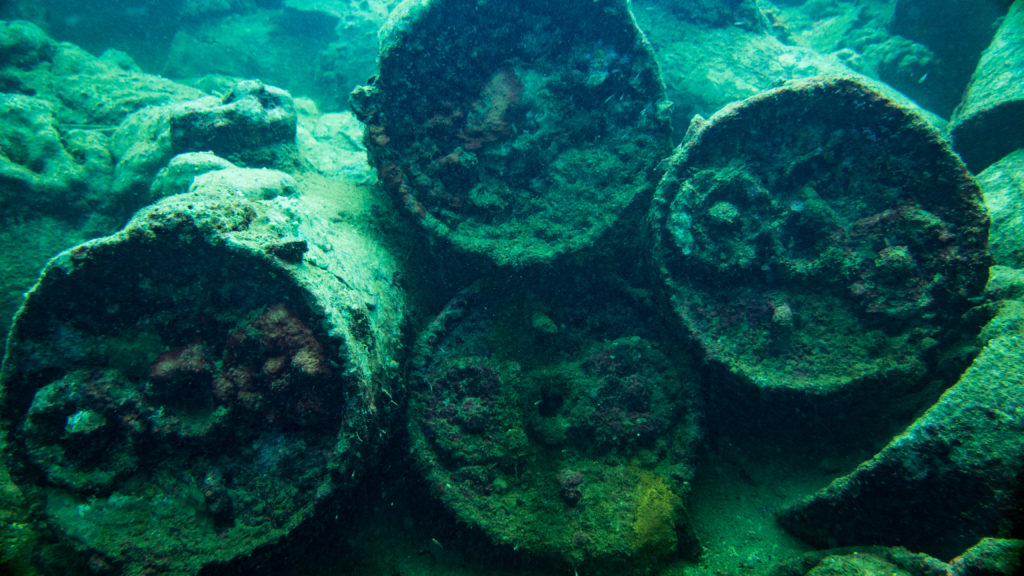
Depth Charges
There are lots of wrecks around Palau, many from the WW2 battles between the US and Japan. The first wreck we dove was a Japanese depth charge transport ship sunk by the US. It still had the depth charges in the hold and they were still live. We were told that these munitions were checked regularly to be safe but not to touch them anyway (as if we needed that warning). Neither of us are huge fans of wreck diving as there are usually few points of interest and that means all the divers converge in small areas. At least with these wrecks being over 70 years old there was some interesting coral formations.
On day 2, with the missing couple finally on board, we moved on to Ulong Channel where we did a hook dive at the Blue Corner. The current at this site can be very strong which means lots of fish life but it also makes it difficult to dive. In order to avoid having to constantly fight the current, each of us was given a large hook which we tied to our BC’s (Buoyancy Compensator for you non-divers) with about 6 feet of line. The plan is to find a piece of dead coral and hook onto it and then just hang from your hook and watch the action (imagine that you are a kite and you’ll get the idea). 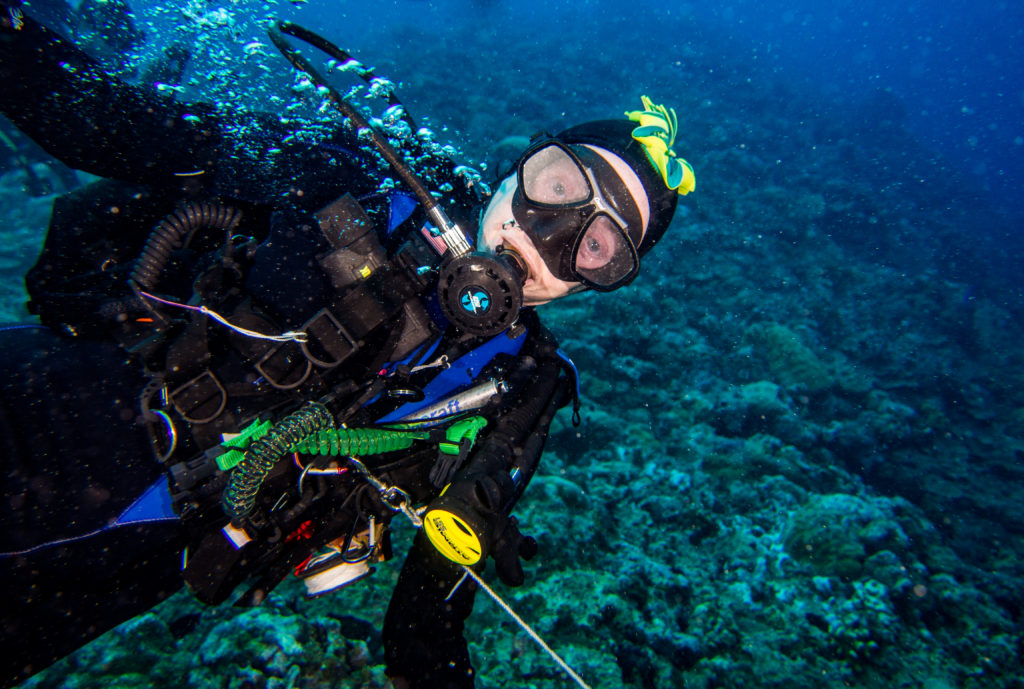 There were lots of fish including a large school of barracuda, but we were mainly watching for sharks and manta rays. We saw plenty of sharks, gray reef and white tips mostly, but no mantas. This is one item that has to stay on the bucket list (crossing our fingers that we have better luck when we go to Wakatobi). Even so, it was a lot fun to feel like we were flying.
There were lots of fish including a large school of barracuda, but we were mainly watching for sharks and manta rays. We saw plenty of sharks, gray reef and white tips mostly, but no mantas. This is one item that has to stay on the bucket list (crossing our fingers that we have better luck when we go to Wakatobi). Even so, it was a lot fun to feel like we were flying.
We did a couple more hook dives, a few walls and a couple of channels. In all cases, the reefs were in very good shape with a large number of fish but we didn’t see a single nudibranch which was a little surprising. I only did one of the night dives, as I was cold and ready for a beer by that time. Bill, of course, did all 3. One was a very uneventful wall dive that he said he would rather have skipped but the other had a large number of critters. Unfortunately, the battery on his camera died half way through so he missed some great photo opportunities (a painful lesson learned).
The best dive of the whole trip was on the 2nd last day. Turns out our trip spanned the new moon which meant we had the opportunity to watch the spawning of the bump-head parrotfish. They grow up to 4 feet in length and can weigh up to 100 pounds. They have a very tall, flat head with a bulbous forehead and during mating, their generally dark green coloring is highlighted by white areas.

Bumphead Parrotfish
After dropping into the water, we swam out into the blue in search of the bump-head, which can be a bit anxiety provoking. There is something about not having a visible destination or point of reference, combined with the exertion of swimming and the struggle to avoid letting yourself drift deeper, that can cause a panicky feeling. Just about the time I started feeling anxious, we saw our first groups of bump-head. They swam back and forth in ever increasing numbers. They were not concerned about our presence, and by the end of our dive we were in the middle of hundreds of them. The ‘mating’ ritual itself is quite interesting. Five or six males suddenly surround a female and as a group they swim rapidly towards surface. The female releases her eggs as they get close to the surface and then the males release their sperm, turning the water cloudy. The fertilized eggs then drift out to sea with the tide and the ‘newborns’ only return to the shallows after they have grown enough to survive. With hundreds of bump-heads in the water, it got pretty frenzied and we were all covered in white stuff by the time we surfaced. Sounds gross, but it was awesome (I didn’t get any pictures because the mating rush moved too fast and there was a lot of “stuff” in the water making focus difficult. The Dive video captures the essence of it though).
On our next to last evening, we enjoyed a beach BBQ where there were LOTS of guess what…rats. This was the first time we’d been on land in six days which took a little getting used to – ground that didn’t move. There was no diving on our last day, to ensure that everyone was safe to fly.

Milky Way Skin Therapy
Instead we went to the Milky Way and a boat tour around some of the other rock islands. The Milky Way is a small turquoise lagoon where the bottom is covered with a white limestone clay mud that locals claim has medicinal properties to make skin younger. One of our crew dove to the bottom several times to fill a bucket with handfuls of the stinky stuff. Most of us covered ourselves in the stuff eager to gain the therapeutic benefits or at least the equivalent of a salt scrub. I don’t think I look 10 years younger but it was fun none the less. Our next stop was some beach combing where we found some beautiful conch shells which we couldn’t take and several hermit crabs (fortunately no rats). The tour wrapped up by wandering around several of the rock islands and seeing some of the defensive positions that the Japanese had built.
Bottom line, we both felt a little underwhelmed with the trip relative to the time and money required. Palau is beautiful with green islands popping up out of the blue green waters of the deep or the bright blue turquoise waters of the shallows. The reefs were healthy with tons of brightly colored fish and soft corals. We saw lots of sharks, several turtles and looking back at Bill’s photos, a few things we hadn’t seen before. I think we may have had overly high expectations of what we would find in what is considered some of the best diving in the world (we have had some great dives in other locations which made it even harder for Palau to meet my expectations).

Blue Dragon
Moving on… we transferred from the boat to the airport at 5pm for our 10pm flight to Manilla. We paid $50 to spend that time in the airport lounge and Bill had booked us a hotel in Manilla so we didn’t have to spend the night at the airport (our flight arrived in Manilla at 12am and the earliest flight to Penang didn’t leave until 6am. We actually booked a flight out at 12pm so we could sleep in). The Marriott upgraded us to a super nice suite (maybe the nicest hotel room we’ve ever stayed in) and we slept in the best bed I have experienced since arriving in Asia (all our AirBnB beds have been extra firm). We had considered spending some time in Manilla, but read that crime was a serious problem, including kidnapping. Still we were very surprised to see security guards with assault rifles at the entrance to the Marriott and a security check for all vehicles before they were allowed to enter the driveway, including checking for bombs on the under-carriage with a mirror. They also had barriers (like you’d find at a US Embassy) erected to prevent cars from crashing past security to the lobby area. Geez. Valentine’s Day morning, it was back to the airport for our flight to Penang including a four-hour layover in Kuala Lumpur. All told, 28 hours from stepping off the boat to stepping into our apartment (do I know how to show a girl a great Valentine’s Day or what).
You can find all of our Palau photos and our dive video HERE.
Next up Chinese New Year in Penang, Malaysia
Post Author: Dessa (with editorial comments by Bill in Italics)
